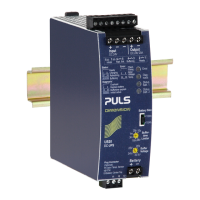Jun. 2020 / Rev.0.1 DS-UB40.241-EN All values are typical figures specified at 24Vdc input voltage, 40A output current in
power supply mode at 25°C ambient, no charging and after a 5 minutes run-in time unless otherwise noted.
www.pulspower.com Phone +49 89 9278 0 Germany
Buffering will start immediately without interruption after the input voltage falls below typically 22.2V. Buffering is possible even if the
batteries are not fully charged.
Buffering can not be started without having previously reached typically 23.0V.
The buffer time (sometimes also called autonomy time) is the maximum period of time for which the battery can maintain the required
output current. The buffer time mainly depends on the capacity and quality of the battery and the output current in battery mode.
Too many buffering events in too short of a time can lead to a 5 second lock for further buffering requests. For example, if there are
multiple 0.2s buffer requests over a duration of 3.3s or multiple 0.3s buffer requests over a duration of 9.2s or multiple 0.4s buffer
requests over a duration of 14s, further buffering requests can be blocked for 5 seconds. Multiple buffer events longer than 0.5s do not
lead to such a 5s lock for further buffering events.
The following times are typical values for a new product in combination with PULS battery modules or with batteries recommended
from PULS. Due to long-term aging effects of batteries consider a buffer time reduction of 30-50% over time. The values apply for a
battery temperature between 20°C and 30°C.
The buffer times are defined for fully charged batteries and can be 10-20% shorter for buffer events, which start immediately after the
“Ready” signal becomes active.
The buffer times apply for a wiring with a wire length of 2x0.5m (equal 0.5m cord length) and a cross section of 6mm
2
(or AWG 10)
between the battery module and the DC-UPS.

